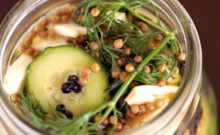In Canada, there are over 800 native bee species, with over 400 species native to Ontario. In this week’s tip, we’ll be giving you a short overview of the different types of native bees found in Ontario.
There are five major families of pollinator bees in Ontario. The Apidae family includes honey bees, bumble bees, carpenter bees, and some solitary bees. Andrenidae includes solitary mining bees. Halictide includes sweat bees, Megachilidae includes leaf cutter and mason bees, and Colletidae includes plasterer bees.
Solitary bees are the most common type of native bees, nesting in pithy plant stems, bare patches of soil, and dirt mounds. You’ll see native bees most active in the spring, especially if you’re out earlier in the day before the honey bees come out.
Carpenter bees like to build their nests in burrows of dead wood or structural timbers. One of the best ways to support these bees is to create nesting blocks using blocks of untreated soft wood like pine or cedar and hang them in a protected area near. If they are already nesting in/near your deck or siding, this can provide them an alternative habitat, after which you can use things like almost oil or varnish to encourage them to move to a new nesting site.

Flickr Carpenter bee (Ceratina calcarata) by Benjamin Smith
Sweat bees like to nest in the ground, and are named because they are often attracted to the salt in perspiration. They only sting if disturbed, and even then the sting is minor. Most native bees are quite gentle, with only the females having a stinger. Native bees generally prefer to go about their business and prefer not to sting humans. It is the most often yellow jackets (a type of wasp), that are often mis-characterized as stinging bees and also nest in the ground.

Flickr Prospecting by Anne Reeves
Many native bees look a lot like different types of flies. They come in a variety of colours and sizes and this great PDF guide with lots of photos by the David Suzuki Foundation provides more information on different pollinators that can be found in Toronto.
One of our favourite native bees is the Squash bee (peponapis pruinosa), which are ground dwelling bees that feed exclusively on squash flowers – including pumpkins, zucchini, and some gourds. They do not feed on watermelons or cucumbers. They live in small solitary nests in the ground and sometimes sleep inside squash flowers just before they wilt, and then chew their way out. Males don’t have a stinger and the females stinger is inconsequential and nothing like a wasp or honey bee, making them easy to pickup without issue. Their gentle and non-aggressive nature certainly helps in this regard as well. Our cover photo for this post is of a squash bee inside a squash flower.
Native bees are often much better at pollinating our food crops and flowers, especially as they are less susceptible to different diseases affecting non-native European honey bees. Pollination allows plants to reproduce, with over $1.2 billion worth of horticultural products dependent on insects for pollination. Think of our produce aisle without apples, cherries, melons, tomatoes, zucchini, and more if we didn’t have these pollinators.
Cover Image by U.S. Department of Agriculture, used under its Creative Commons license.
[Got a Tip?] If you have a tip to share with your fellow urban farmers, let us know at tips@youngurbanfarmers.com. If you want help setting up a pollinator friendly garden and attracting native bees to your home or office garden, check out our Gardening Services. Want More Tips? Browse our Tips Archive for more.






